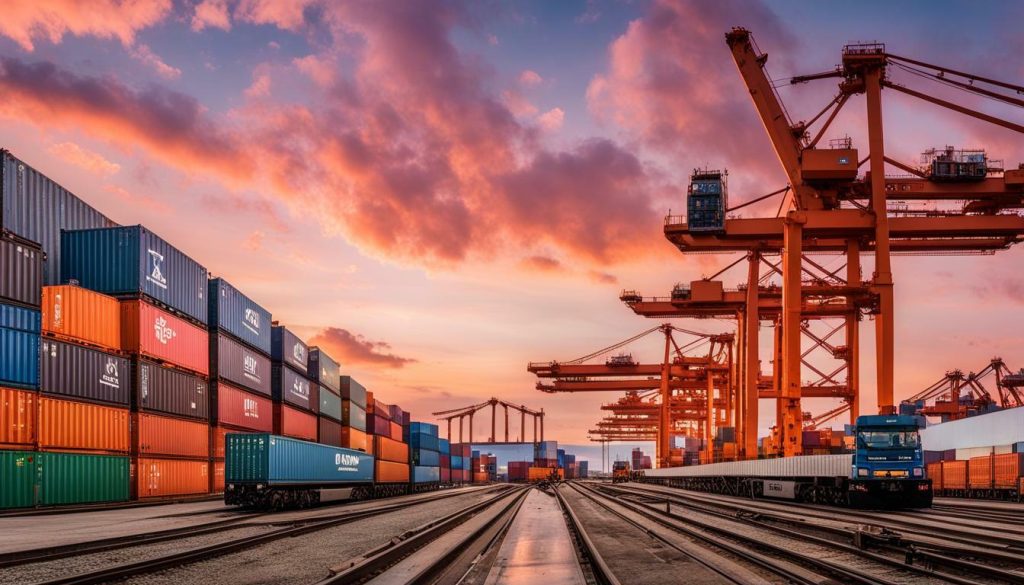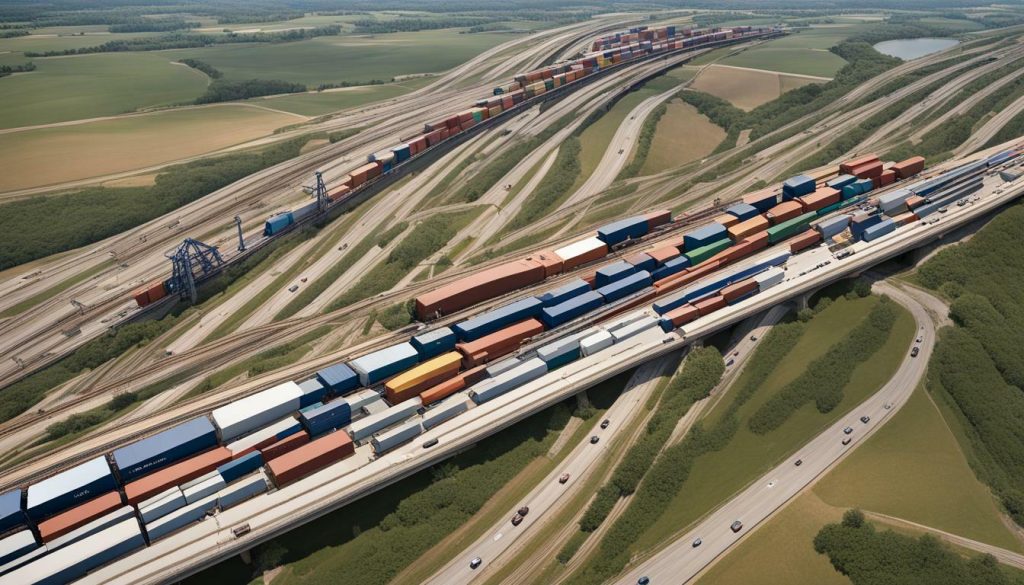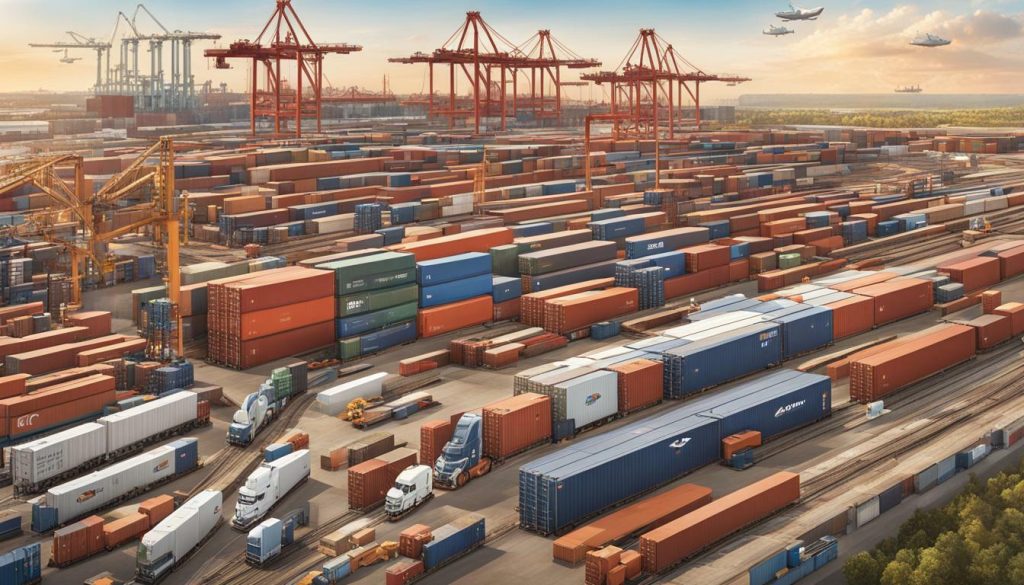If you’re a business that relies on shipping goods, optimizing your intermodal freight transport routes is crucial to your success. Efficient logistics can significantly impact overall operations, saving time and money. To achieve this, it’s essential to understand intermodal transport networks, logistics routes and the significance of multimodal transport routes in the supply chain.
By optimizing your intermodal shipping routes, you can reduce transportation costs, improve delivery times, and increase customer satisfaction. This can ultimately lead to a more successful business with repeat customers.
Key Takeaways:
- Efficient logistics is crucial for businesses that rely on shipping goods.
- Optimizing intermodal freight transport routes can save time and money.
- Understanding intermodal transport networks and logistics routes is essential to achieving efficient shipping routes.
- Multimodal transport routes play a vital role in the supply chain.
Table of Contents
Understanding Intermodal Freight Transport Routes
Intermodal transport networks refer to a combination of at least two modes of transportation, such as trains, trucks, ships, and planes, to move goods from one place to another. Logistics routes are the paths goods follow from the point of origin to the destination, and can consist of intermodal transport networks.
Every logistics route requires a plan that addresses equipment, personnel, infrastructure, and transportation modes. Multimodal transport routes refer to a combination of different transportation modes, such as trucks and ships, trains and planes, that follow a logistics route to move goods.
Intermodal transport networks and logistics routes are significant in the efficiency of the supply chain. They can help businesses to optimize their freight transportation, reduce costs, and improve customer service. By understanding intermodal transport networks, businesses can take advantage of the flexibility and efficiency of multimodal transport routes.

The use of intermodal transport networks and logistics routes can also help businesses to reduce the environmental impact of their operations. By reducing the number of trips and the total distance travelled, they can help to reduce emissions and lower the carbon footprint of the supply chain.
Strategies for Optimizing Intermodal Freight Transport Routes
In today’s global economy, optimizing your freight transportation operations is essential for staying competitive. Efficient shipping routes and international trade routes play a crucial role in ensuring that your business meets the demands of customers and suppliers.
One of the primary strategies for optimizing your intermodal freight transport routes is focusing on efficient shipping routes. This involves identifying the most direct routes and modes of transportation and customizing them to your specific needs. By doing so, you can reduce transportation time and costs, as well as minimize the risk of delays and disruptions.
Another important strategy is exploring international trade routes. By expanding your reach beyond domestic markets, you can tap into new revenue streams and increase your profit margins. However, navigating international trade can be challenging, and it’s essential to have a comprehensive understanding of logistics and regulations.
Partnering with reliable and experienced freight transportation providers is also crucial for optimizing your intermodal shipping routes. These providers can offer expertise and resources that you may not have in-house, ensuring that your transport operations run smoothly and efficiently.
New technologies are also emerging to streamline intermodal freight transport routes. These technologies include advanced logistics software, real-time tracking and monitoring tools, and automated systems. By utilizing these innovations, businesses can gain greater visibility into their supply chains and make more informed decisions.
It is essential to regularly review and assess your intermodal freight transport routes to identify further opportunities for optimization. Continuously analyzing data, evaluating performance metrics, and seeking out new strategies and technologies can help ensure your business stays ahead of the competition.
Overall, optimizing your intermodal freight transport routes is essential for staying competitive in today’s fast-paced and global market. By focusing on efficient shipping routes, exploring international trade, partnering with experienced providers, and utilizing new technologies, you can improve your operations and drive growth.

Technology Solutions for Intermodal Freight Transport Routes
Advancements in technology have greatly impacted the optimization of intermodal freight transport routes. Logistics routes and efficient logistics systems have emerged as critical factors in enhancing the efficiency of supply chains. Implementation of modern technologies such as Internet of Things (IoT), Big Data analytics, and Artificial Intelligence (AI) can streamline the intermodal freight transport routes, increasing efficiency and improving overall operations.
The integration of IoT sensors with intermodal freight transport routes provides real-time information on the location and condition of goods, enabling businesses to track and manage their shipment in real-time. This technology ensures that businesses can take corrective measures in case of any discrepancies that may occur during transportation. The use of Big Data analytics in logistics routes helps in identifying inefficiencies and trends, enabling businesses to make informed decisions to optimize their intermodal freight transport routes.
The use of AI in logistics operations can improve operational efficiency by predicting potential disturbances in intermodal freight transport routes. AI-powered systems can analyze vast amounts of data to identify potential issues before they occur, allowing businesses to make appropriate decisions. These technologies also enable the optimization of intermodal freight transport routes by evaluating factors such as traffic, weather conditions, and delays.

Implementing these technology solutions can greatly benefit businesses that rely on intermodal freight transport routes. They can improve operational efficiency, reduce costs, and enhance customer experience. However, businesses need to invest in these modern technologies to gain the benefits of optimization of intermodal freight transport routes.
Conclusion
Optimizing your intermodal freight transport routes is crucial to the success of your business and the efficiency of global supply chain routes. By adopting strategies that ensure smooth transit of shipments, you can significantly improve your logistics operations and stay ahead of the competition.
Remember, the first step to optimizing your logistics routes is to understand your intermodal transport networks and the significance of multimodal transport routes in the supply chain. Once you have a clear understanding of your freight transportation requirements, you can identify the best strategies to employ.
Technology solutions are available to streamline your intermodal freight transport routes. By embracing efficient logistics systems, you can reduce operational costs and improve delivery times. Additionally, leveraging international trade routes can help you expand your business and reach new markets.
Take Action Now
Don’t wait until your logistics operations are struggling to take action. Conduct an audit of your intermodal freight transport routes and identify areas of improvement. Adopt the necessary strategies and leverage technology solutions to optimize your logistics routes and stay ahead of the game.
FAQ on Intermodal Freight Transport Routes
Q: Why is optimizing intermodal freight transport routes important for businesses?
A: Optimizing intermodal freight transport routes is important for businesses because it allows for more efficient logistics, reducing costs and improving overall operations. By optimizing shipping routes, businesses can minimize transportation time and maximize the use of different modes of transportation, resulting in enhanced supply chain management.
Q: What are intermodal transport networks and logistics routes?
A: Intermodal transport networks refer to the interconnected routes that allow for the movement of goods using multiple modes of transportation, such as truck, rail, and sea. Logistics routes, on the other hand, are the specific paths or routes that goods take within these networks. They are carefully planned to ensure the most efficient and cost-effective transportation of goods.
Q: How do multimodal transport routes work?
A: Multimodal transport routes involve the seamless integration of different modes of transportation to move goods from one point to another. For example, a shipment may start by truck, then be transferred to a train or ship, and finally be delivered by truck again. This combination of transportation modes allows for greater flexibility, cost savings, and efficiency in freight transport.
Q: What strategies can businesses use to optimize their intermodal freight transport routes?
A: Businesses can employ several strategies to optimize their intermodal freight transport routes. These include analyzing transportation data to identify bottlenecks or inefficiencies, utilizing advanced route planning software, collaborating with logistics partners, and leveraging international trade routes to enhance global supply chains.
Q: What technology solutions are available to streamline intermodal freight transport routes?
A: There are various technology solutions available to streamline intermodal freight transport routes. These include advanced logistics software that helps with route optimization, real-time tracking systems that provide visibility into shipments, and automated systems for managing documentation and customs clearance. These technological advancements greatly improve the efficiency and accuracy of logistics operations.


